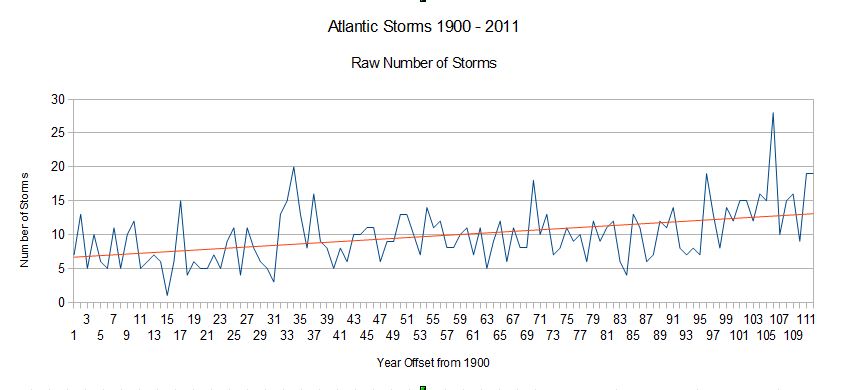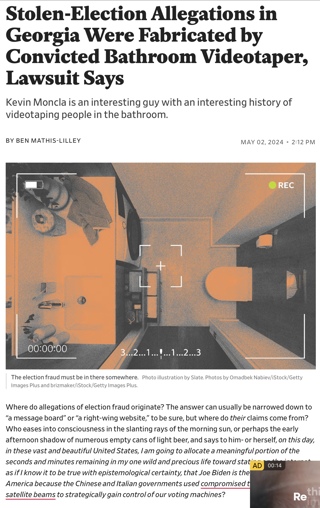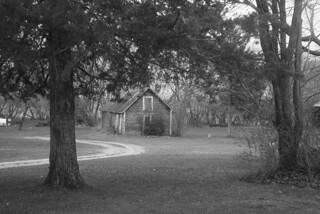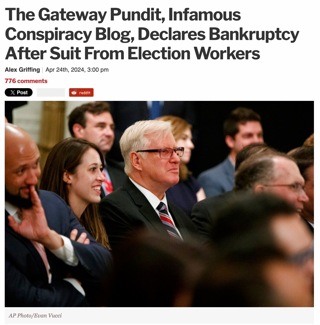The Marc Morano Fudge Factor: Links to Steve Goddard Nonsense
Corrected Dec 8.12 - see below…
Marc Morano, a infamous AGW denialist, debated Bill Nye the Science Guy on CNN recently. During the debate Morano peppered the air with a vituperative Gish Gallup aimed at Bill who was standing in for the climate science community.
Morano threw too many talking points for Bill to field effectively and as is common when a scientist goes up against a professional PR hack, he looked outclassed and flustered. I suspect Bill simply wasn’t prepared for the volume and blatant dishonesty.
It would take a rather lengthy paper to dismantle every point Morano made, so I decided to take a look at a couple of related arguments. One of Morano’s arguments revolves around the evidence for increased severe weather and the use of hurricane Sandy as an example of the effects of AGW on the Atlantic storm season.
In a well rehearsed and technically correct cherry picked comment, Morano links to a Steve Goddard article where Goddard mentioned the 1935 Labor Day hurricane as the strongest storm to ever hit land in the US. The implication is that for AGW’s affect on severe weather to be true, past storms can not be as strong as current storms. A ridiculously illogical statement, but that’s the intended message.
 Most Powerful Atlantic Hurricanes to hit the US (Figure 1)
Most Powerful Atlantic Hurricanes to hit the US (Figure 1)As you can see by Figure 1, the Labor Day hurricane is indeed the most powerful to have hit the coast, based not on damage done but on atmospheric pressure.
What Morano Goddard fails to mention is that in any given year there is an energy reserve that is split between the number of yearly storms. That means there could be a small number of severe storms as in 1883 when there were 4 storms, a cat 1, two cat 3s and a cat 4, or a large number of small storms as in 1901 when there were 13 storms, four cat 1s, one cat 2 and the rest never reaching hurricane status, or a combination.
The two graphs shown above are weighted to give a rough indication of the Atlantic energy reserve. They are back of the envelope models. The first graph, Figure 2 has non-hurricane storms (tropical storms and tropical depressions) weighted at 1, so the number of those storms are added together. Hurricanes are weighted according to strength, category 1 are given a weight of 2, category 2 are given a weight of 3 and so on. Weighting values are completely arbitrary because we aren’t interested in absolute energy values, just in whether the energy reserves are trending or flat. To show that the values chosen don’t skew the results appreciably, the second graph uses smaller weightings. Category 1 weight is 1.1, category 2 is 1.2, category 3 is 1.3 and so on.
It’s obvious from both Figure2 and Figure3 that the energy store in the Atlantic is trending upward.
One consequence of an increased store of energy is that the number of storms will go up as shown in the above graph.
 Most Powerful Atlantic Hurricane. (Figure 4)
Most Powerful Atlantic Hurricane. (Figure 4)A second consequence of increased available energy is the severity goes up. This doesn’t mean that every year will necessarily have more severe storms than the previous year, or that any given storm will break previous severity records. What it means is the probability of a severe storm will trend upwards. For example a one in a century storm could become a one in a half, or quarter century storm.
The table (Figure4) posted above shows that is happening. Contrary to what Morano Goddard intends the listener to infer, all storms are important, not just those landing on the US coast. Of the top 11 Atlantic storms, 6 of them have occurred since 1997. Only 3 predate the time AGW has become obvious.
What can be learned from this is that because we observe the number of storms increasing, the probability of severe storms going up, as well as an increasing Atlantic ocean energy content, less energy is re-radiating out to space.
___________________________________________________________
Update:
After reading Morano’s post about this article, I listened to the debate again to find where he commented on the 1935 hurricane. His comments at his site are correct, he did not mention that hurricane in the debate. The comment was from Steve Goddard on the ‘Real-Science’ blog.
The most active period for major hurricanes in the US was 1931-1960. The frequency of major hurricanes is now about half what it was 60 years ago. The most intense hurricane to ever hit the US occurred in 1935.
Morano’s blog, climatedepot.com has a page labelled “AZ-Climate-Reality-Check” which is anything but a reality check, but contains a link to a page referencing the Goddard page.
My apologies to Marc Morano for claiming he said something in a debate he didn’t say, although he obviously agrees with it given the links on his site.
My apologies to Charles Johnson for publishing a page with bad information. I was obviously confused by the support given to Goddard by Morano on climatedepot.com.
All errors in this page are mine, and mine alone.















